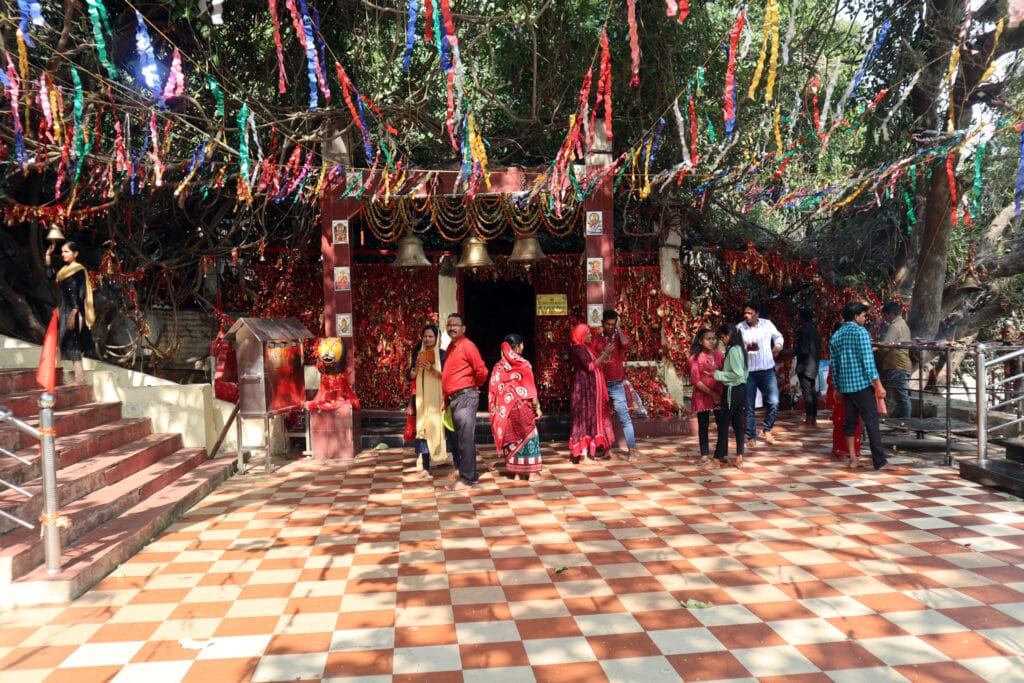Maa Ghanteswari Temple: A Sacred Haven on the Banks of Mahanadi
Maa Ghanteswari Temple: A Sacred Haven on the Banks of Mahanadi
Nestled amidst the serene landscapes of Sambalpur, the Maa Ghanteswari Temple stands as a testament to both spirituality and natural beauty. Renowned for its unique feature of being adorned with countless bells, this sacred abode has drawn pilgrims and tourists alike from across the state. The temple, located 33 kilometers southwest of Sambalpur, holds a significant place in the hearts of the locals, serving as the Heart of Chipilima, a picturesque picnic spot.

The Bells of Fulfillment:
As the name suggests, the temple is adorned with bells, known as ‘Ghanti’ in the local language. Devotees flock to Maa Ghanteswari Temple to offer bells after the fulfillment of their wishes. This tradition has given the temple a distinct identity, being the only place of its kind in the state of Orissa. The melodic symphony of bells resonates through the air, creating an atmosphere of divine grace and fulfillment.
A Beacon of Light Without Light:
The history of Maa Ghanteswari Temple dates back to a time when it played a crucial role in navigation along the Mahanadi River. Positioned strategically on the riverbank, the temple was often referred to as a lighthouse without light. The area’s treacherous currents, formed by the confluence of three streams of the Mahanadi, created a whirlpool that posed a threat to passing boats. The temple, with its large bells, served as an auditory guide, warning navigators of the dangerous currents and preventing disasters.
The Legend of the Wind and Bells:
Legend has it that the temple derived its name from the goddess Ghanteswari. In the past, large bells on the temple grounds, swayed by the powerful winds of the region, produced resonant sounds that echoed far and wide. This audible signal became a crucial beacon for sailors, alerting them to the hazardous waters ahead. Thanks to the wind and the bells, many boats were spared from the perilous currents of the confluence.
Transformation after Hirakud Dam:
With the construction of the Hirakud Dam, the dynamics of the region changed. The dam brought safety to the once-treacherous waters, making the temple area more accessible. While the perilous currents were tamed, the temple’s significance as a divine sanctuary remained intact. Pilgrims continued to visit, not just seeking spiritual solace but also to witness the unique charm of the temple adorned with thousands of bells.
By Train: Travelers opting for the railway route can alight at the nearest railway station, Hirakud, which is conveniently located around 20 kilometers from Maa Ghanteswari Temple. The well-connected railway network ensures a smooth journey for pilgrims and tourists alike.
How to Reach
By Road: For those who prefer the scenic route, traveling by road is an excellent choice. The journey can commence from either Sambalpur city or the Hirakud Station. Follow the Bargarh-Sambalpur Road until you reach Goshala, a key landmark in your journey. Once in Goshala, take the Chipilima Road, situated on the left side, which leads directly to Maa Ghanteswari Temple. The road journey offers picturesque views and a chance to soak in the natural beauty of the region.
Local Transportation: Upon reaching the vicinity of Maa Ghanteswari Temple, local transportation options such as buses, taxis, or auto-rickshaws are readily available to take you to the temple premises. These short-distance modes of transportation provide convenience and ensure a hassle-free arrival at the sacred site.
Travel Tips:
- Plan your trip considering the proximity of airports and railway stations to ensure a comfortable and time-efficient journey.
- Check the availability of transportation services from the airports and railway stations to the temple.
- Confirm the location and accessibility of the new airport in Jharsuguda, which may become a prominent entry point in the future.
- Embrace the scenic beauty of the Bargarh-Sambalpur Road and Chipilima Road for a delightful road journey.
Embark on a journey to Maa Ghanteswari Temple, where spirituality meets natural splendor, and create memories of a pilgrimage filled with cultural richness and divine serenity
Related Post
-
Opps, No posts were found.
